The Lunar Eclipse on 3 March 2007
A group of UCL Physics and Astronomy Undergraduates gathered at UCLO to watch the lunar eclipse together. The weather held throughout and they could watch a spectacular event - "the best lunar eclipse since 1992", to quote UCLO Director Mike Dworetsky.
The students could observe the eclipse through the Fry refractor with a 2 inch eyepiece that gave a large full view of the moon. They also made use of the 10 inch LX-200 Meade telescope and binoculars.

The Allen dome with the eclipsed moon above it; note that the man in the moon smiles happily at all the attention (Photograph by Thomas Schlichter, Canon PowerShot A80 with TC-DC52A Tele-converter, ISO 400, f/4.9, 10s).
Observers using the Fry Telescope made timings of the passage of the shadow across lunar features during the partial phases in order to compare with predictions and measure the size of the Earth's shadow accurately.
The shadow timings were very close to predicted times using Danjon's Rule for the atmospheric enlargement of the Earth's shadow, indicating that the shadow predictions for this eclipse were correct. However, the shadow size can vary unpredictably from one eclipse to the next, for reasons that are not completely understood.
According to our visual estimates, on the Danjon Scale of lunar eclipse brightness, the total phase started dark, at scale point 2, and gradually brightened to 3 towards the end of totality, with half the disk rated at 3.5.
Dr Francisco Diego took the following images from his back garden in South London with his digital SLR camera (Canon EOS DIGITAL REBEL XT) on a Meade 8 telescope working at f/5, ISO 50. Partial phases are exposed at 1/250s, totality at 15s (click images for large views).
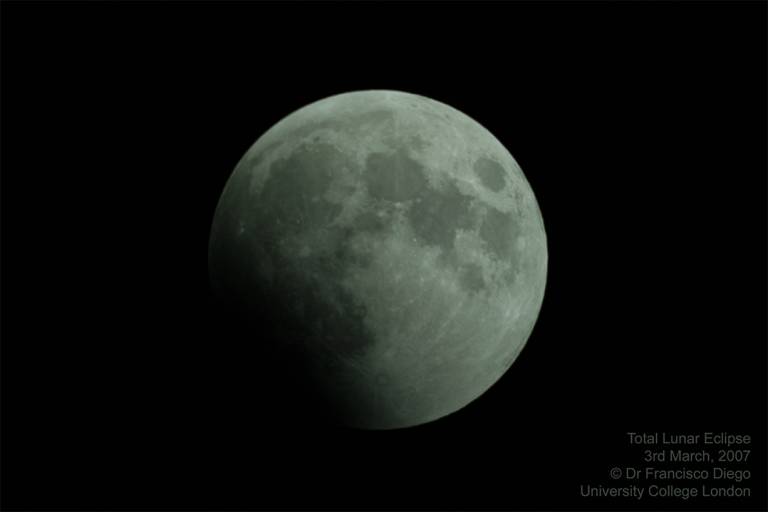
Moon entering the Earth's shade
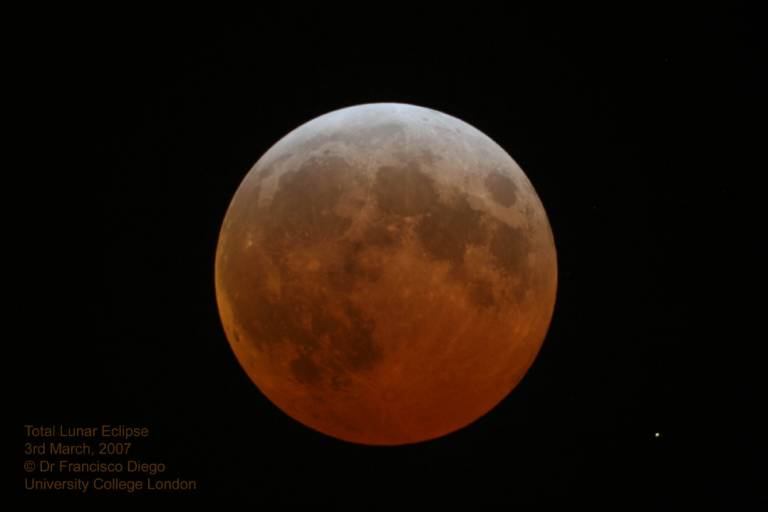
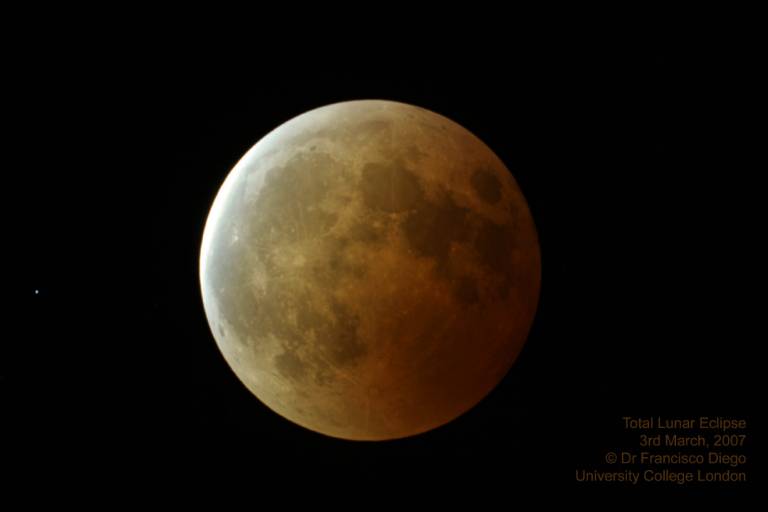

Bob Barber supplied images which were taken by his friend Paul Farrington MRCVS from a dark site in Berkshire, using a hand-held Nikon D50 with a 300 mm lens. The images were then combined by Thomas Schlichter using the GIMP Image Editor:
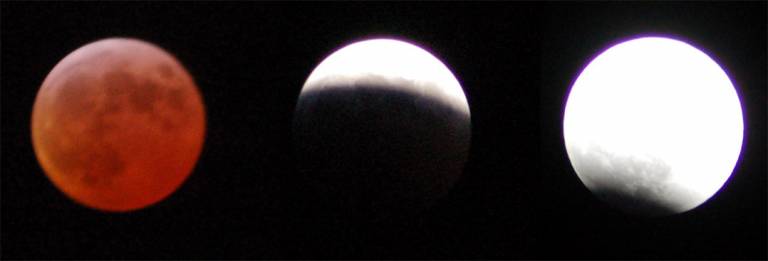
Moon images taken with handheld camera.
Comet McNaught (C/2006 P1)
Clear weather on 10 January 2007 made it possible to observe the comet from London despite its low position in the evening sky.
Although the position of the Comet made it very tricky to observe with the Radcliffe Telescope, Steve Fossey and Stephen Boyle managed to take images - with the telescope pointing just above the horizon.
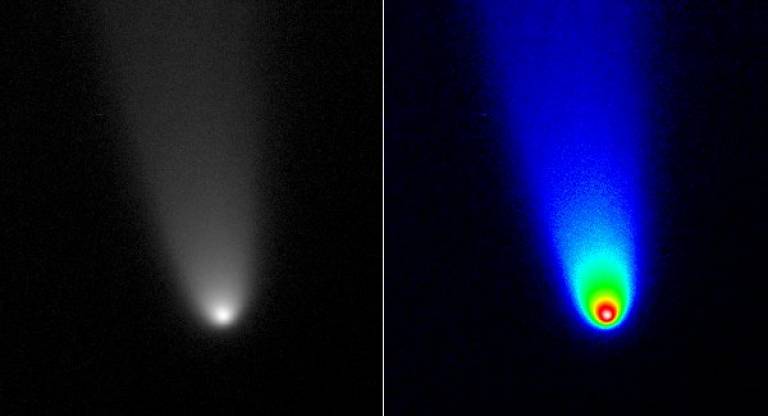
The above image of the nucleus and inner coma of Comet McNaught (C/2006 P1) was obtained with the Radcliffe 24-inch refracting telescope and Wright Instruments AT-1 CCD camera on 10 January 2007. The field is a few arcminutes across; North is up and East is to the left. The 5-second exposure was taken through a narrow-band H2O+ filter. The colourized image uses colours to represent different intensities and highlights detail in the inner coma, but it is otherwise identical to the greyscale image.
The pictures below were taken by Mick Pearson and Thomas Schlichter from Mill Hill Park near the Observatory, from where there is an excellent view of the Western horizon.
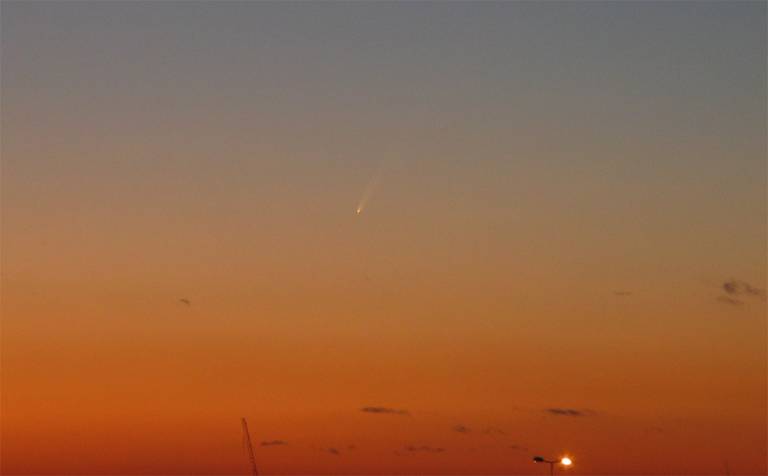
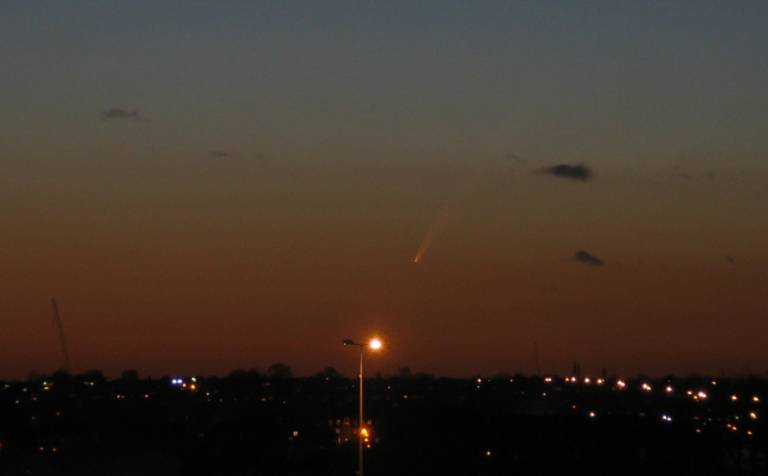
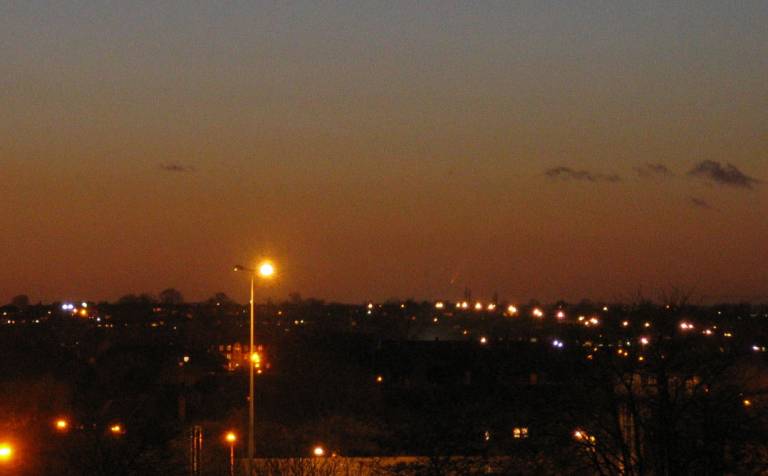
The images were taken using a Canon PowerShot A80 with a TC-DC52A Tele-Converter.
Mick Pearson put together an animated GIF image (0.9MB) made up from several of the images taken that evening that shows the comet moving across the evening sky.
AN ANIMATED GIF IMAGE OF THE COMET CAN BE VIEWED BY FOLLOWING THIS LINK...
On the same evening Dr. Francisco Diego took images from Ruskin Park in South London with a Canon EOS DIGITAL REBEL XT:
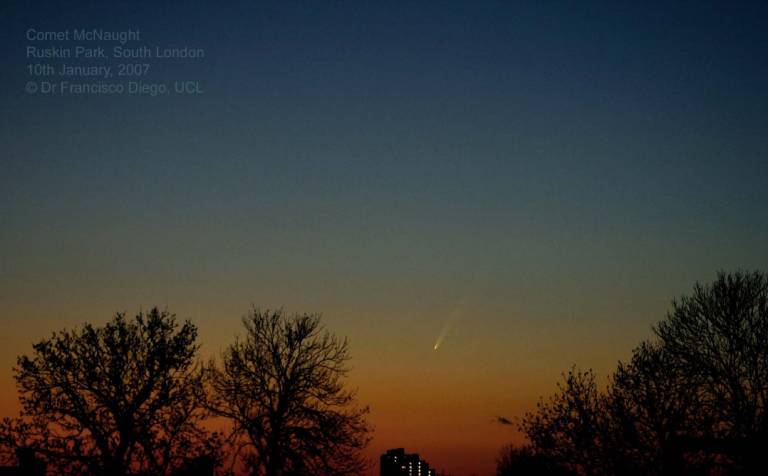
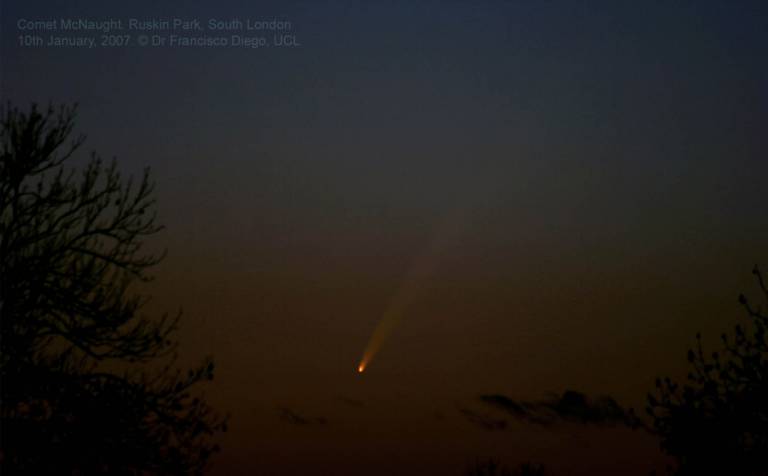
Comet McNaught (C/2006 P1) on 10 Jan 2007 (ISO 100, f/5.6, 0.8s, 300mm).
Comet 17P/Holmes, November 2007
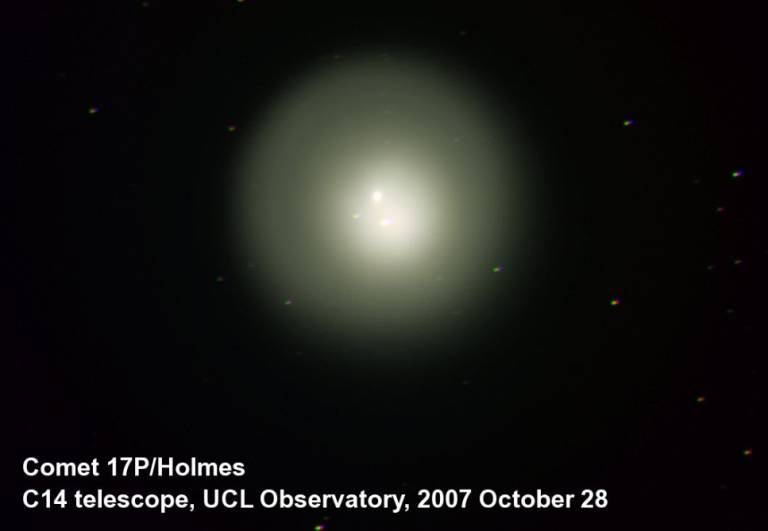
This image of Comet 17P/Holmes was taken at about midnight GMT on the night of 28/29th October 2007, with the Celestron 14-inch telescope and STL-6303E CCD camera.
North is up and East is to the left. The image is a composite of several images taken through red, green and blue filters, each about 30 seconds exposure. The star images are slightly trailed due to the time difference of a few minutes between the RGB exposures.
The cometary nucleus is the bright condensation in the upper part of the central coma of dust and gas; the other bright points are background stars. The whole diffuse coma is several arcminutes across, and is noticeably expanding in size from night to night.
The comet's tremendous increase in size over the next month can be seen in the composite image below.
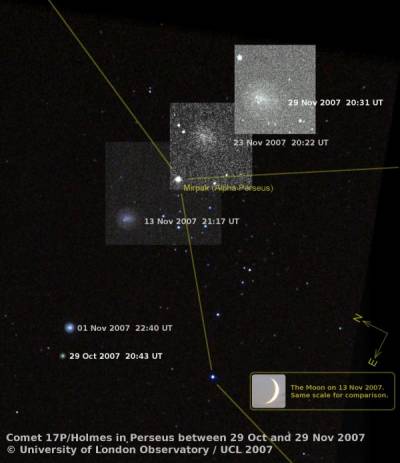
The images were taken with a Canon A80 digital camera with TC-DC52A Tele-converter and 3x Zoom. Image processing was done with The GIMP 2.2 and Georg Hennig's Astro Plugins, stack registration with Christian Buil's IRIS 5.51 under Linux ( Kubuntu 6.06 LTS with Wine).
Image information:
29 Oct 2007: added stack of 5 images (6s, ISO 50, f/4.9),
01 Nov 2007: merged stack of 3 images (6s, ISO 400, f/4.9),
13 Nov 2007: merged stack of 3 images (6s, ISO 400, f/4.9),
23 Nov 2007: merged stack of 4 images (5s, ISO 50, f/4.9),
29 Nov 2007: merged stack of 7 images (5s, ISO 200, f/4.9).
Discovery by Edwin Holmes in 1892
The following article was taken from "The Observatory", December 1892, No.195, pp.441:
Discovery of a New Comet in Andromeda
We have had very little decent weather for observing in London of late, but I make a practice of never missing an opportunity.
Sunday, November 6th, was far from clear, and did not improve as the night deepened, so that after looking at Jupiter and a few double stars and finding the seeing unsatisfactory, I made up my mind to close observing at 11.30 P.M.
Ever since the temporary star appeared in M 31, I have taken an observation of that nebula at every chance I have had in case any further outbreak took place, and on Sunday night it occured to me to try whether I could see the small comes to μ Andromedæ under such conditions. On swinging the telescope round from β I caught something nebulous in finder and mistook it for M 31. Going to the eyepiece of reflector I recognized at once that it was not the nebula and called out involuntarily, “What is the matter? there is something strange here.” My wife heard me and thought something had happened to the instrument, and came to see. I recognized at once that it was a new comet, but before I could get more than a rough position clouds hid it. I said to my wife: “This is coming end on, and will be a big fellow, and I must get a position before I leave it if possible.” I wrote at once to Mr. Maunder, Mr. Maw and Mr. Kidd, of Bramley, and posted, and then got clearer sky, and with Slade micrometer made it immediately preceding Σ 72, the interval of passing the centre being 1m 10s at a single trial.
Having only restricted sky room, I was unable to make a second measure or see if motion was perceptible. I measured the diameter of the nebulosity as exactly five of the one minute divisions of the micrometer. As these are calculated for a 6-feet focus, and my focus is 78½ inches, the estimated diameter is rather over than under the mark, but I consider the milky state of the sky somewhat reduced apparent diameter, and that probably 5' is exact. The position in declination is very close also, as both comet and star travelled accurately on wire. As regards R.A., the difference did not exceed 1m 10s I am sure, but it may have been 1s less.
On Monday morning I wrote the Astronomer Royal, but as I omitted to say I saw the Andromeda Nebula at the same time, he very naturally at first thought I had blundered. My friend Mr. Kidd, with whom I have corresponded for years, and to whom I am indebted for much counsel and kindness, also suspected a mistake, but on Monday evening he saw the comet with the naked eye, as did also Mr. Bartlett of Bramley. I wrote again to Greenwich, and being now satisfied of the reality of the discovery, they took measures to spread necessary information. Mr. Maw accepted the matter at once and wrote to congratulate me.
It is unnecessary for me to enter into any particulars of further observations because they are sure to be furnished by those with better and more exact appliances, at any rate as regards position; but perhaps my impressions of change, when seen a second time on November 14th, at 10.45, may have some value, because no one but myself and Mrs. Holmes appears to have seen it for some days after its first appearance with any telescopic means. On the 14th the nucleus was much less distinct and much less bright, the boundary of the nebulosity was much less well defined and less perfectly circular and far more like a nebula. The intrinsic brilliancy was less, but the diameter largely increased. Only getting a look at it betwixt clouds and showers, I was not able to measure, but by comparison with the half-field of Slade micrometer I estimated the diameter at from 8' to 9'.
It will be a pleasure to learn that others have had better weather than myself, and gathered a large number of facts for our instruction.
EDWIN HOLMES.
The article is published with permission from the editors of The Observatory.
The temporary star in M31 mentioned by Edwin Holmes was probably the Supernova in M31 in August 1885 (S Andromedæ or SN 1885A).
The article is available in various formats via ADS and can be retrieved as PDF file here.
Building Work July 2008
The Fry floor, kitchen, sitting area, Control Room and the Toilets have all been successfully refurbished and provide much improved and more spacious facilities for students and staff.
The Wilson Building was completely stripped and has been repainted, and new windows fitted. The driveway area has been surfaced with fresh shingle.
The Radcliffe Foyer had a makeover and is now used as an area for Theodolite training, a waiting area for visitor groups and exhibition space where we now display some historical equipment previously in use at the Observatory. This includes the spectrograph used by Miss E. M. Peachey (who was later known as Dr E. M. Burbidge) during the 1940s.
The Observatory is now fully open for teaching and public visits.
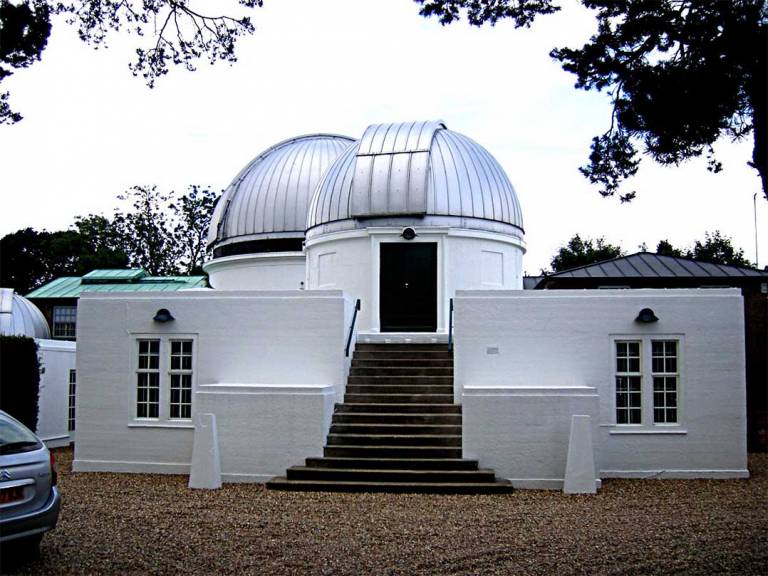
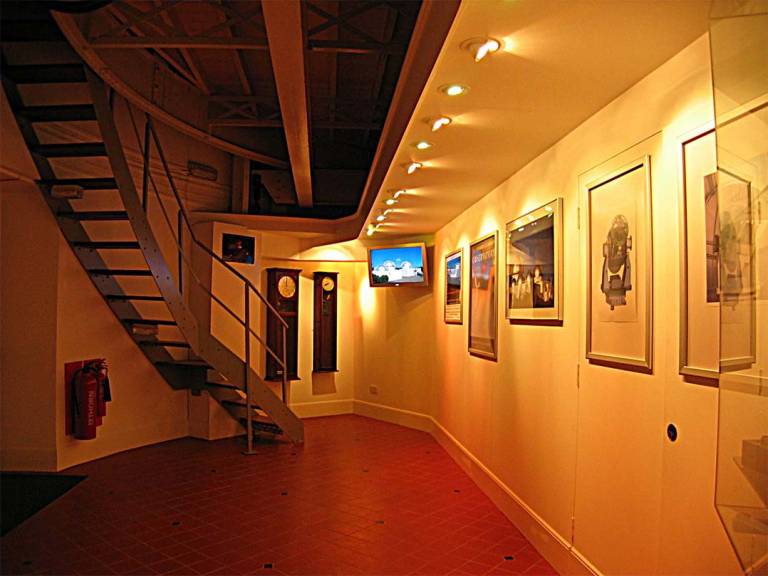
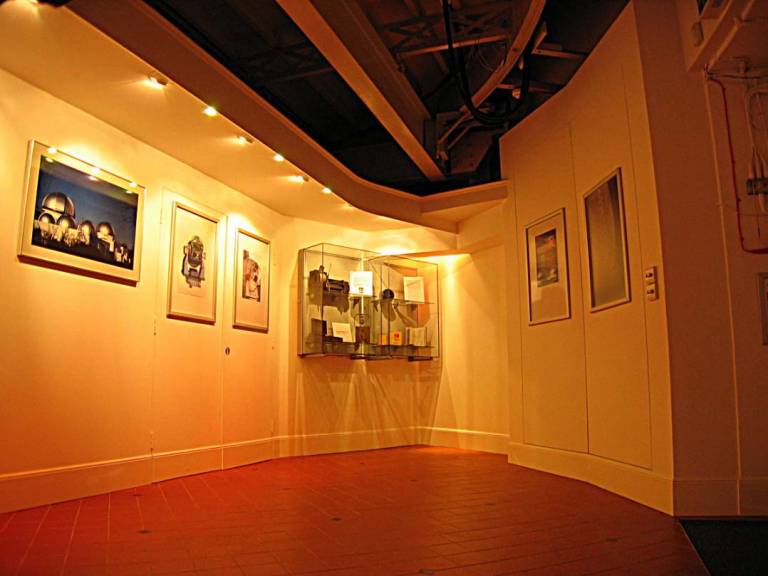
... and the right side with the exhibition cases.
Building Work 2007:
Kitchen, sitting area, Control Room and the Toilets have all been successfully refurbished and provide much improved and more spacious facilities for students and staff.
The Wilson Building was completely stripped and has been repainted. It now awaits the fitting of new windows.
Work in the Fry Building to replace the floor has resumed and we hope to be able to bring the Fry Telescope back to use soon.
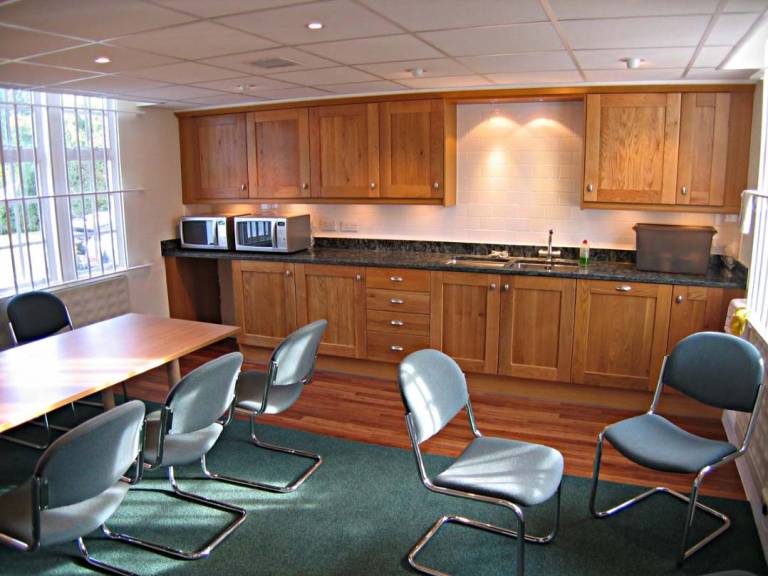
New kitchen in Wilson Building
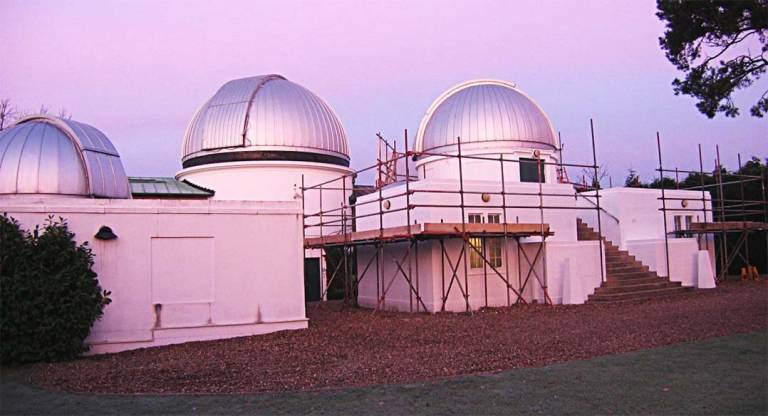
The Wilson building freshly painted, facing the rising sun on a clear and frosty November morning
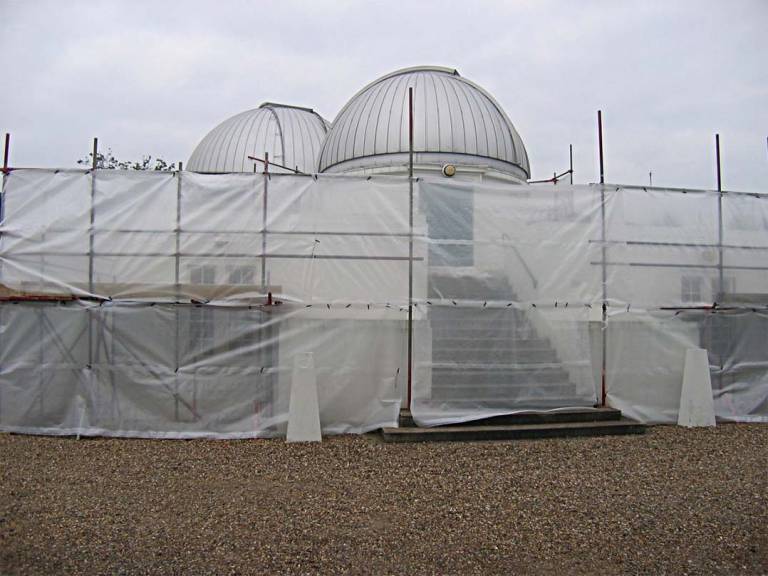
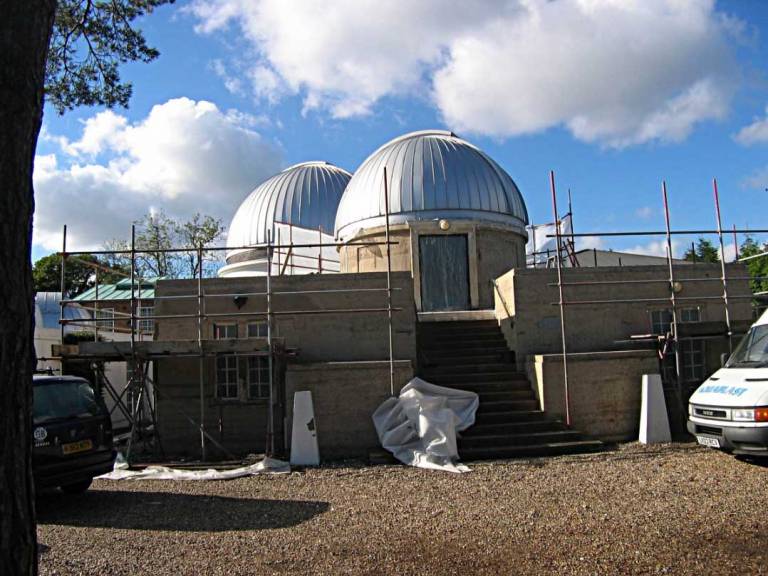
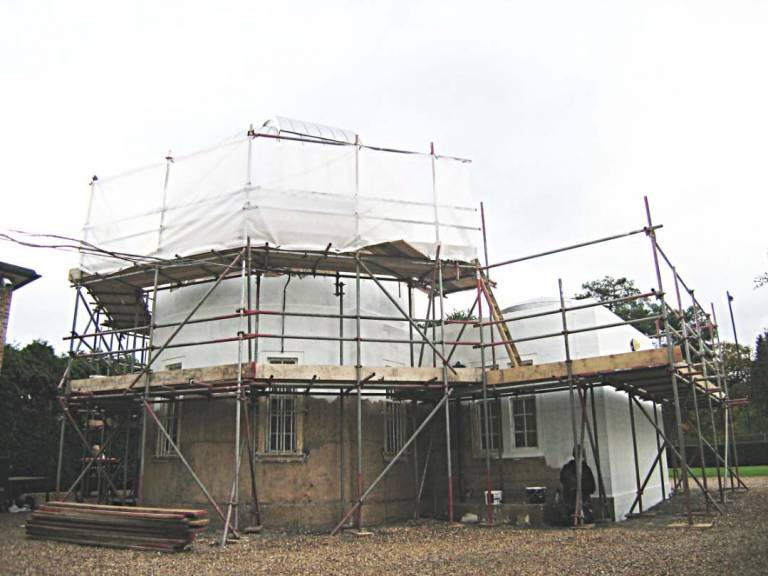
Summer Building Work at the Observatory
During the Summer months of 2007, the Observatory will be undergoing a programme of renovations. This building work involves the renovation and re-organization of the ground floor rooms in the Wilson Building and its external stripping and repainting, floor repairs to the Fry dome, and construction of a partition to create a foyer under the Radcliffe. There is also scheduled redecoration of other areas such as the North classroom and complete refurbishment of the toilets.
As a result, the Observatory is closed to visitors until the end of September. The computer network remains operational and most of the routine administrative, teaching, and research tasks can be carried out (except most observing and telescope maintenance). The library is mostly accessible. It is hoped that the Celestron C-14 can be available later during the Summer because it is the easiest telescope to uncover.
Dr. Mike Dworetsky
Director, University of London Observatory
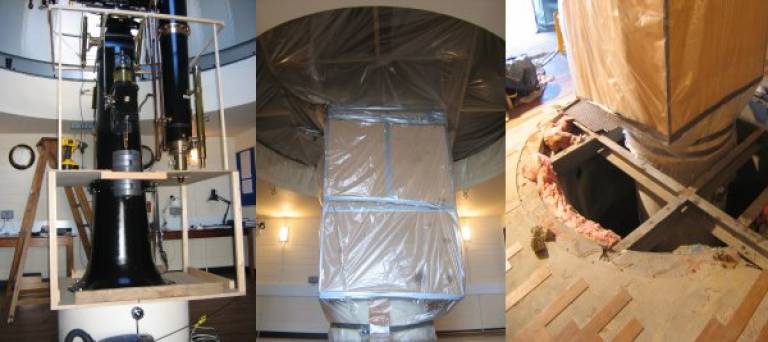
The Fry telescope while being boxed in, completely wrapped up, and with the floor partially removed.
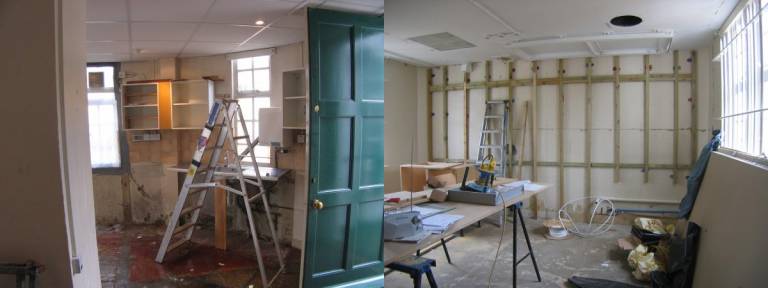
The old kitchen has been removed and the new kitchen will be built in the former Coelostat room.
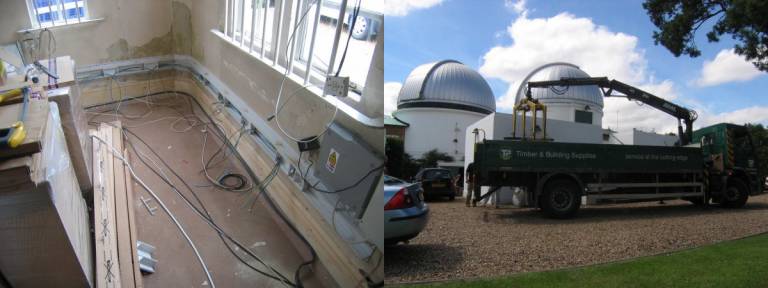
The control room is going to be completely refurbished & Delivery of building materials.
Nagty 2007
On 14th August, the facilities at UCLO were used by the NAGTY (National Academy for Gifted and Talented Youth) Astrophysics Summer School 2007. This is a two-week residential course for 11-16 year-olds, based at Imperial College London, and led by Dr Adam Burnley. The theme of this year's summer school was the Sun, covering everything from solar activity and the solar cycle through to solar evolution.
After a tour of UCLO, the students embarked upon a day of activities. Unfortunately, the truly dreadful weather made solar observing impossible; however, everyone had chance to see a demonstration of the workings of the Radcliffe telescope, and to examine, close up, one of the Meade telescopes. The students also undertook a computer-based experiment to determine the rotation period of the Sun using sunspot data. In addition, there was the opportunity to study a number of Mount Palomar Sky Survey prints, searching for objects such as interstellar dust clouds and planetary nebulae.
This was the first visit to an astronomical observatory for most of the seventeen participants. Despite the awful weather, the event was a huge success, with everyone getting an incredible amount from their day at UCLO.
UCLO demonstrators Rosie Willatt and Matt Austin introduced the students to the telescopes and helped them using the astronomical software.
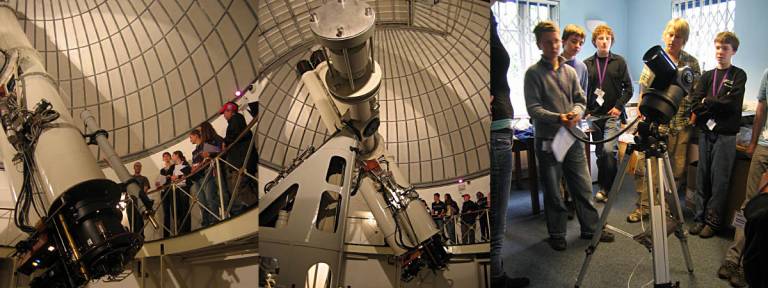
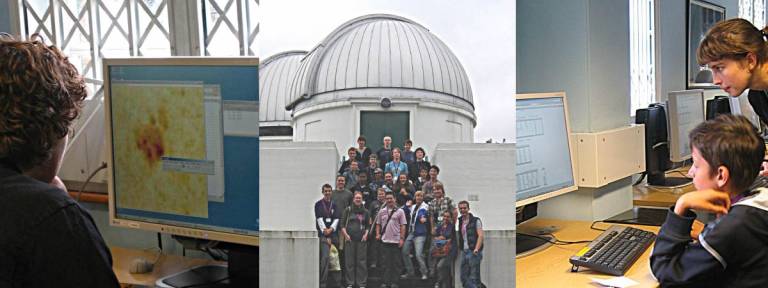
London Open House
"Extremely interesting." "Fascinating visit--many thanks." "Mill Hill takes on new focus." "Love the telescopes! Beautiful building!" "Clear explanations."
These were a few of the many comments from our Open House visitors. We were open five-hours on Sunday only, and we had 260 visitors of all ages. The weather was warm and sunny, and we set up a special telescope for solar viewing on the front lawn. Visitors toured the telescope buildings in guided groups and saw the Allen, Fry, Celestron and Radcliffe telescopes.
We thank all the visitors for their enthusiasm and cooperation, and express our gratitude to our UCL student and staff guides who helped by explaining the observatory's history and the ways we use the different telescopes.
London Open House Announcement
Sunday 21 September 2008 11.00am to 4.00pm
The Observatory will be open for one day during London Open House weekend. Guided tours will be conducted with last entry at 4.00pm. The Observatory is a popular venue, so those planning a visit are advised to arrive as early as possible. All visitors must be part of a guided tour which will take approximately 30-40 minutes. The event is on the basis of first come, first served. No advance bookings will be possible.
Extrasolar Planet Observing Programme
Twenty-five UCL undergraduate students gathered at UCLO for the first ExoCafe meeting on 5th June 2008, to discuss setting up an observing programme to monitor transiting extrasolar planets.
The ExoCafe Wiki has been set up to organise the project work, and several students have trained to observe with the C14 telescope and are standing by to make observations over the summer. Read more at the Project Page....
 Close
Close

